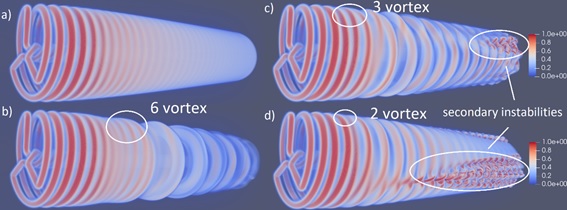Floating offshore wind turbines (FOWTs) with Winc3D
Floating offshore wind turbines (FOWTs) are the next frontier in offshore wind energy, allowing exploration of deep-water regions previously unavailable to fixed-foundation turbines. Those turbines have a few advantages over onshore ones such as they operate at more steady and strong wind conditions and the produced noise does not impact local fauna. For FOWT, platform motion induced by wind and wave loads can trigger vortex instabilities, modifying the wake structure, possibly influencing the flow reaching downstream wind turbines. We study those effects by the means of Large Eddy Simulations (LES) with Actuator Line Method (ALM), implemented in the software WInc3D, where heave motion with different frequencies is imposed. A few results are given in the figure. For the lowest frequency of heave motion (half of the blade rotation), several vortices (mostly often six) coalesce to form a large flow structure. High amplitude of oscillations in the streamwise velocity were observed due to these flow structures, which may increase fatigue or induce high amplitude motion on downstream turbines. For higher frequencies of heave, fewer vortices merge together (two of three), producing smaller coalesced structures. However, due to the resulting more complex flow configuration, secondary instabilities occur, increasing the turbulent kinetic energy, which could also cause impacts on downstream turbines.
Simulation: Lucas Franceschini / USP

